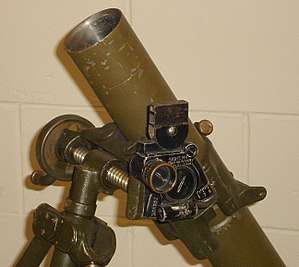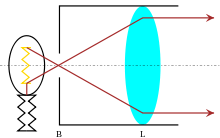Collimator sight
A collimator sight is a type of optical sight that allows the user looking into it to see an illuminated aiming point aligned with the device the sight is attached to, regardless of eye position (with little parallax).[1] They are also referred to as collimating sights [2] or "occluded eye gunsight" (OEG).[3]

Description

The basic layout of a collimator sight is a closed tube with a lens at its open end and a luminous reticle mounted near the closed end at the focus of the lens, creating an optical collimator. The reticle is illuminated by an electronic light source (an incandescent light bulb or, more recently, a light-emitting diode) or by ambient light gathered behind the reticle via an opalescent window or fiber optic light pipe. Collimator sights are a relatively old idea,[4] being used in many forms for almost 100 years.[5]
Usage
These sights are 'blind' sights; that is, they are used with both eyes open while one looks into the sight, with one eye open and moving the head to alternately see the sight and then at the target, or using one eye to partially see the sight and target at the same time.[6]
Applications
Collimator sights as weapon sights are considered to be very simple, rugged and low cost devices.[7] They have been used on mortars and field guns since World War I. There have had more modern incarnations such as the Armson Occluded Eye Gunsight (OEG) and the Normark Corp. Singlepoint.[8] These both used a light gathering rod in a protective clear dome collecting ambient light to illuminate a 'dot' style reticle.
Collimator sights have had uses as a small arms sight for low light situations (such as twilight or "room clearing" operations) since there is no intervening optical window that can block the light, allowing the use of both eyes with a relatively un-obstructed field of view.[9] In recent years the introduction of illuminated reflex sights, and even telescopic sights; (for example the Advanced Combat Optical Gunsight (ACOG) using the "Bindon Aiming Concept") have replaced dedicated collimator sights since these other types of sights can be used with both eyes in the role of a collimator sight.
References
- Elementary optics and application to fire control instruments By United States. Dept. of the Army, section 8-24, p. 177.
- William C Farmer, Ordnance field guide, p. 279
- Jan Kay, International Defense Directory, 1991–92, p. 241
- Surveillance and target acquisition systems A. L. Rodgers - 1983 – p. 201
- America's munitions 1917–1918: Report of Benedict Crowell, THE ASSISTANT SECRETARY OF DIRECTOR OF MUNITIONS , United States. War Dept - 1919 - p. 142
- Elementary optics and applications to fire control instruments: May, 1921 By United States. Army. Ordnance Dept, p. 84
- Elementary optics and applications to fire control instruments: May, 1921 by United States Army Ordnance Dept, p. 82, THE COLLIMATOR
- Hearst Magazines (September 1970). Popular Mechanics. Hearst Magazines. p. 44.
- Maj. Michael J. Stroff III, USMCR, Night Marksmanship: A Step Forward, Marine Corps Gazette; vol 74 no 4; Apr 1990; pp. 44-45 illus